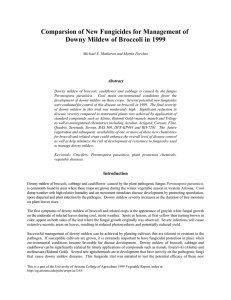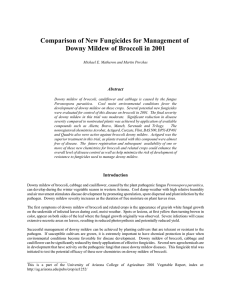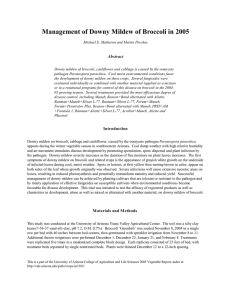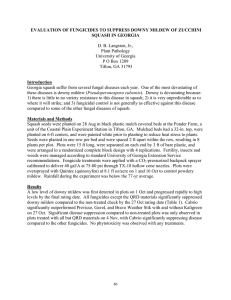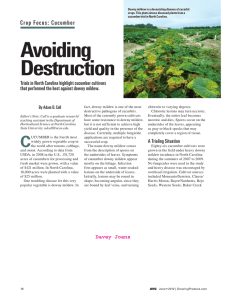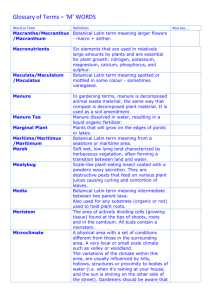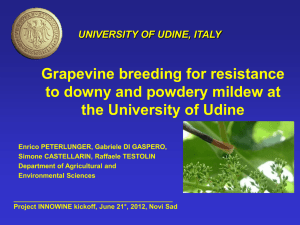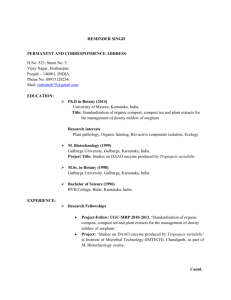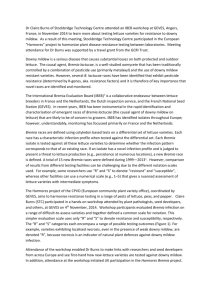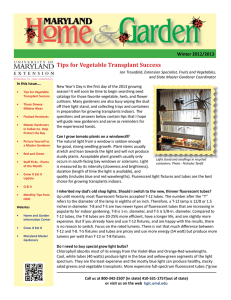Comparison of Fungicides for Management of Abstract
advertisement
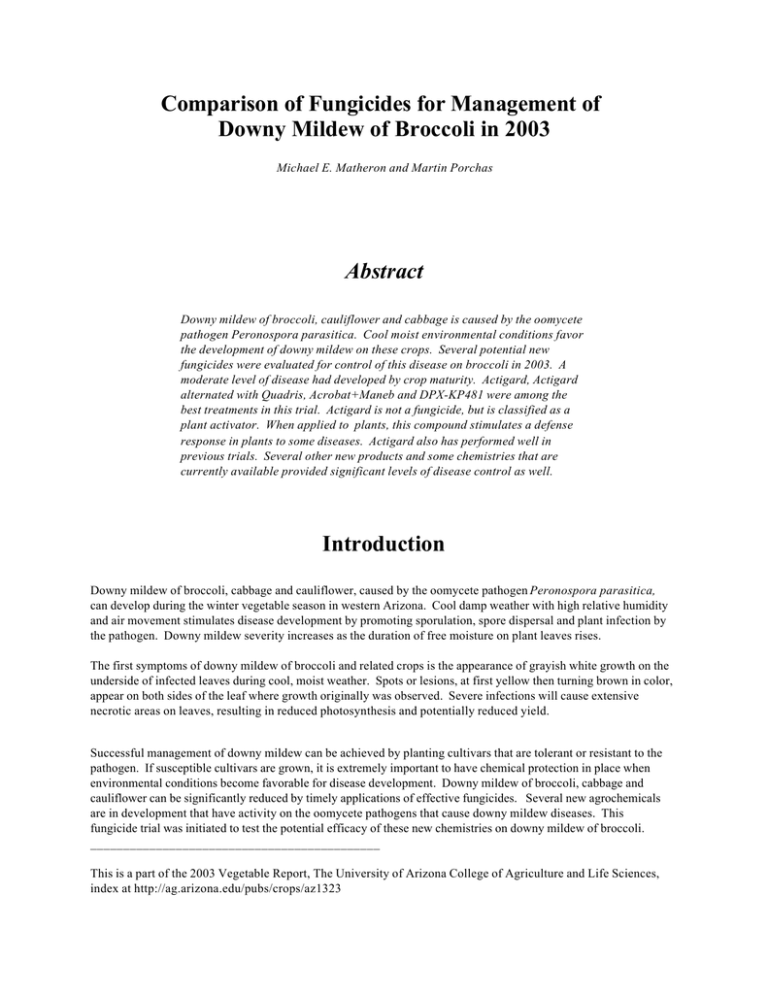
Comparison of Fungicides for Management of Downy Mildew of Broccoli in 2003 Michael E. Matheron and Martin Porchas Abstract Downy mildew of broccoli, cauliflower and cabbage is caused by the oomycete pathogen Peronospora parasitica. Cool moist environmental conditions favor the development of downy mildew on these crops. Several potential new fungicides were evaluated for control of this disease on broccoli in 2003. A moderate level of disease had developed by crop maturity. Actigard, Actigard alternated with Quadris, Acrobat+Maneb and DPX-KP481 were among the best treatments in this trial. Actigard is not a fungicide, but is classified as a plant activator. When applied to plants, this compound stimulates a defense response in plants to some diseases. Actigard also has performed well in previous trials. Several other new products and some chemistries that are currently available provided significant levels of disease control as well. Introduction Downy mildew of broccoli, cabbage and cauliflower, caused by the oomycete pathogen Peronospora parasitica, can develop during the winter vegetable season in western Arizona. Cool damp weather with high relative humidity and air movement stimulates disease development by promoting sporulation, spore dispersal and plant infection by the pathogen. Downy mildew severity increases as the duration of free moisture on plant leaves rises. The first symptoms of downy mildew of broccoli and related crops is the appearance of grayish white growth on the underside of infected leaves during cool, moist weather. Spots or lesions, at first yellow then turning brown in color, appear on both sides of the leaf where growth originally was observed. Severe infections will cause extensive necrotic areas on leaves, resulting in reduced photosynthesis and potentially reduced yield. Successful management of downy mildew can be achieved by planting cultivars that are tolerant or resistant to the pathogen. If susceptible cultivars are grown, it is extremely important to have chemical protection in place when environmental conditions become favorable for disease development. Downy mildew of broccoli, cabbage and cauliflower can be significantly reduced by timely applications of effective fungicides. Several new agrochemicals are in development that have activity on the oomycete pathogens that cause downy mildew diseases. This fungicide trial was initiated to test the potential efficacy of these new chemistries on downy mildew of broccoli. ____________________________________________ This is a part of the 2003 Vegetable Report, The University of Arizona College of Agriculture and Life Sciences, index at http://ag.arizona.edu/pubs/crops/az1323 Materials and Methods This study was conducted at the Yuma Valley Agricultural Center. The soil was a silty clay loam (7-56-37 sand-siltclay, pH 7.2, O.M. 0.7%). Broccoli ‘Greenbelt’ was seeded and watered Oct 30, 2002 on double rows 12 inches apart on beds with 40 inches between bed centers. Treatments were replicated five times in a randomized complete block design. Each replicate consisted of 25 feet of bed, which contained two 25 foot rows of broccoli. Plants were spaced 6-7 inches apart and treatment beds were separated by single non-treated beds. Treatments were applied with a tractor-mounted boom sprayer (flat-fan nozzles spaced 12 inches apart) that delivered 50 gallons/acre at 100 psi. Foliar applications of fungicides were made December 19, 2002 and Jan 7, 2003. Maximum and minimum ranges (EF) for air temperature were as follows: December (2002), 53-75, 30-50; January (2003), 68-87, 37-52. Maximum and minimum ranges (%) for relative humidity were as follows: December, 72-100, 19-66; January, 60-100, 13-46. Total rainfall in inches was as follows: December, 0.00; January, 0.03. Furrow irrigation was used for the duration of this trial. The severity of downy mildew caused by Peronospora parasitica was determined at plant maturity by counting the number of downy mildew lesions on each of 10 plants randomly selected from each of the five replicate plots per treatment. Results and Discussion A moderate level of disease had developed by crop maturity. Actigard, Actigard alternated with Quadris, Acrobat+Maneb and DPX-KP481 were among the best treatments in this trial. Actigard is not a fungicide, but is classified as a plant activator. When applied to plants, this compound stimulates a defense response in plants to some diseases. Actigard has performed well in previous trials as well. Several other new products as well as some chemistries that are currently available provided significant levels of disease control, as shown in the able. Downy mildew of broccoli fungicide trial, 2003. Michael Matheron and Martin Porchas, Yuma Agricultural Center, University of Arizona. Treatment Rate Number of (lb a.i./A) diseased leaves 1 Actigard 50WG 0.03 26.0 Actigard 50WG 0.03 alternated with Quadris 2.08SC 0.25 27.8 2 Acrobat 50WP + Maneb 75DF 0.2 + 1.5 28.0 DPX-KP481 50WG 0.25 30.2 DPX-KP481 50WG 0.375 30.4 BAS 545 (400 g/l) 0.05 31.4 2 Acrobat 50WP + Bravo Weatherstik 0.2 + 1.12 32.0 BAS 545 (400 g/l) + Kinetic 0.07 + 1.0 fl oz 32.0 Maneb 75DF 1.5 32.0 BAS 545 (400 g/l) 0.07 32.4 Quadris 2.08SC 0.25 32.8 Sonata AS 2.0 qt product 33.2 Curzate 60DF + Maneb 75DF 0.187 + 1.5 33.6 Cabrio 20WG (BAS 500) 0.18 35.0 Acrobat 50WP 0.2 37.0 Sonata AS 4.0 qt product 37.0 Serenade AS 4.0 qt product 37.4 Reason (500 g/l) 0.18 37.6 Curzate 60DF 0.187 37.8 Curzate 60DF + Maneb 75DF 0.187 + 1.12 38.6 Ridomil Gold Bravo 76.5WP 1.96 38.8 Flint 50WG 0.125 39.0 Serenade AS 4.0 qt product alternated with Bravo Weatherstik 1.12 39.0 Zoxamide 80WP 0.2 alternated with Maneb 75DF 1.5 39.8 Reason (500 g/l) 0.27 40.6 Ridomil Gold Bravo 76.5WP 2 1.96 41.0 Pristine 38WG (BAS 516) 0.4 41.4 Zoxamide 80WP 0.2 42.4 Non-treated control ------49.2 LSD (Least Significant Difference, P=0.05) 3 4.5 1 Number of leaves on 10 plants per replicate with downy mildew lesions. 2 Applied only on the second application date (Jan 7). All other treatments were applied on Dec 19, 2002 and Jan 7, 2003. 3 Values differing by more than the least significant difference are significantly different from each other according to the Duncan-Waller K-ratio test.
